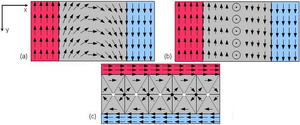Néel wall
A Néel wall (after Louis Néel ) is a domain wall type in which the rotation of the magnetization of a thin layer of magnetic material takes place entirely in the plane of the layer.
If the two domains are named A and C, and the middle of the wall between them B, one has roughly the sequence with regard to the magnetization directions for the Néel wall .
In contrast, the following sequence applies to the Bloch wall with regard to the directions of magnetization . Here the circle symbol with a point means a directional arrow protruding vertically from the xy plane. The course to the right and left of the center is complicated, which is indicated by two points each.
Mathematical treatment
The following applies: where describes the vertical distance to the center of the wall and where a complicated function is a very large range that indicates the course of the magnetization from the value + π / 2 at x = -∞ to the equivalent value -π / 2 at x = + ∞. It is sufficient to calculate in the left half of the wall, since the right and left half of the wall define each other. -
This completely planar transition has a very long range, includes many atomic distances and is calculated numerically.
In the case of very thin ferromagnetic layers, which are essentially described by two variables (by x and by the planar direction of magnetization) , the Néel domain wall type is energetically more favorable than the Bloch wall type, in which the rotation takes place perpendicular to the plane, so that three Variables come into play (x and the components M y and M z ).
The mathematics for the Bloch wall is largely analogous to the Néel case, with apparently unimportant, in reality essential differences in terms of the components involved, which means that the Bloch wall, unlike the Néel wall, is source-free and therefore does not generate a magnetic stray field .
Where is again for -. The x, y and z components of the magnetization vector are given, the function being less complicated compared to and having a much shorter range.
Inferences
If the variable x describes the distance from the wall, the magnetization direction of the Néel wall type is only dependent on the two "thin-film variables" x and y. In the case of the Bloch wall, which is more applicable for three-dimensional systems (three coordinates: x, y and z), the direction of magnetization also changes with the variable x, but in such a way that the direction of magnetization with x is one in the wall plane, the yz plane , remaining spiral runs through.
The wall thicknesses of the Néel or Bloch walls depend on the material parameters, but are consistently in the range of many atomic distances.
application
In somewhat thicker layers, instead of the Néel walls, spiked walls appear (English technical term: cross-tie wall ), which contain more complicated magnetization structures instead of the Néel transition areas. The number of “spikes” on such a wall can be counted and changed in a targeted manner, which has been implemented in information technology ( Racetrack memory ).
Specialist literature
- Horst Stöcker : Pocket book of physics. 4th edition, Verlag Harry Deutsch, Frankfurt am Main, 2000, ISBN 3-8171-1628-4
- Alex Hubert and Rudolf Schäfer : Magnetic Domains , Berlin, Springer 2000, ISBN 3-540-64108-4
Individual evidence
- ↑ S. Middelhoek, J. Appl. Phys. 34, p. 105 (1963) ( Memento of the original from March 24, 2016 in the Internet Archive ) Info: The archive link was inserted automatically and has not yet been checked. Please check the original and archive link according to the instructions and then remove this notice.
- ↑ SU Jen, SP Shieh, SS Liou: Néel-, Cross-tie-, and Bloch-walls in Fe 100-x Ni x , JMMM 147, p. 49-54 (1995)



![{\ displaystyle {\ vec {M}} _ {Neel} \ \ propto [\, \ cos f_ {N} (x), \, \ sin f_ {N} (x) \, \ 0],}](https://wikimedia.org/api/rest_v1/media/math/render/svg/ca3a912a643be66272eefc7a1d2f6a9f58840b83)
![{\ displaystyle x \ in [- \ infty, + \ infty]}](https://wikimedia.org/api/rest_v1/media/math/render/svg/09c91068702df069c78b7645ed9199edfe87f959)

![{\ displaystyle {\ vec {M}} _ {\, {Bloch}} \ propto [0, \ cos f_ {B} (x), \, \ sin f_ {B} (x)],}](https://wikimedia.org/api/rest_v1/media/math/render/svg/9dd36a179031f26d7689823e91d95169d72648c6)



